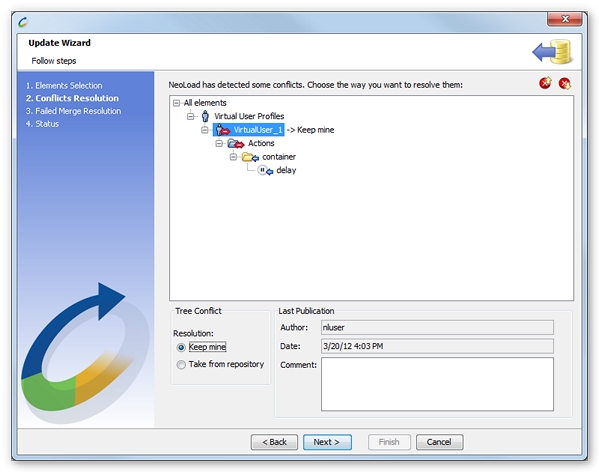Updates with tree conflicts
When one of the two team members has ignored the element itself whereas the other members have modified it, an element tree conflict is identified.

This may occur in the following situations: Deleting, renaming, or moving the element or its hierarchy. It may also happen when Member 1 and Member 2 have both modified the element tree or hierarchy, or when only one of them has updated the recorded content of a shared Virtual User, as described in Update recorded content. Two resolution modes are available in NeoLoad to process a tree conflict. If Member 1 has made the update, the wizard suggests the following actions:
- Keep mine: The changes made by Member 2 are ignored and the changes made by Member 1 are kept.
- Take from repository: The changes made by Member 1 are ignored and the changes made by Member 2 are kept.
- Tip: NeoLoad also makes it possible to take no decision. Team members can then work together to understand the conflict reasons.
In the Update Project wizard, a red tag with an icon represents a tree conflict. The name of the element involved is followed by the selected resolution mode.
|
Example |
Meaning |
|---|---|
|
|
Double red arrow with a – (minus) sign: The VirtualUser_3 Virtual User is in a tree conflict situation. It has been deleted on the server. |
|
|
Double red arrow with a + (plus) sign: The VirtualUser_3 Virtual User is in a tree conflict situation. It has been added onto the server. |
When a tree conflict is detected, the wizard displays the Conflicts Resolution screen.

The resolution mode options for the conflict are:
- Keep mine: The local component is used to update the project.
- Take from repository: The collaboration server component is used to update the project.
Only Virtual Users can be selected in a tree conflict situation, whereas all the elements can be selected in a content conflict situation. Resolution actions must be undertaken at the Virtual User level for a tree conflict.

